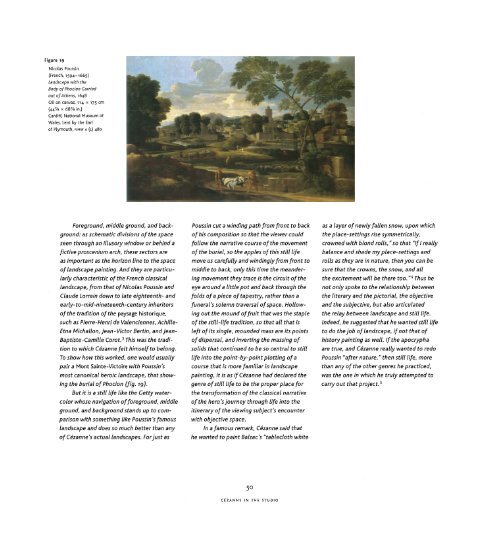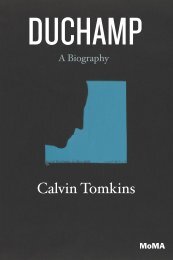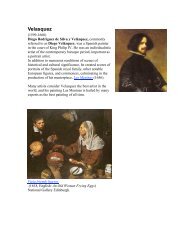Still Life in Watercolors
qbj8dgc
qbj8dgc
- No tags were found...
Create successful ePaper yourself
Turn your PDF publications into a flip-book with our unique Google optimized e-Paper software.
Figure 19<br />
Nicolas Pouss<strong>in</strong><br />
(French, 1594-1665)<br />
Landscape with the<br />
Body ofPhodon Carried<br />
out of Athens, 1648<br />
Oil on canvas, 114 x 175 cm<br />
(44 7 /s x 68 7 /s <strong>in</strong>.)<br />
Cardiff, National Museum of<br />
Wales. Lent by the Earl<br />
of Plymouth, NMW A (L) 480<br />
Foreground, middle ground, and background:<br />
as schematic divisions of the space<br />
seen through an illusory w<strong>in</strong>dow or beh<strong>in</strong>d a<br />
fictive proscenium arch, these sectors are<br />
as important as the horizon l<strong>in</strong>e to the space<br />
of landscape pa<strong>in</strong>t<strong>in</strong>g. And they are particularly<br />
characteristic of the French classical<br />
landscape, from that of Nicolas Pouss<strong>in</strong> and<br />
Claude Lorra<strong>in</strong> down to late eighteenth- and<br />
early- to -mid-n<strong>in</strong>e teen th -cen tury <strong>in</strong>heritors<br />
of the tradition of the paysage historique,<br />
such as Pierre-Henri de Valenciennes, Achille-<br />
Etna Michallon, Jean-Victor Bert<strong>in</strong>, andJean -<br />
Baptiste-Camille Corot 3 This was the tradition<br />
to which Cézanne felt himself to belong.<br />
To show how this worked, one would usually<br />
paira Mont Sa<strong>in</strong>te-Victoire with Pouss<strong>in</strong>'s<br />
most canonical heroic landscape, that show<strong>in</strong>g<br />
the burial ofPhodon (fig. 19).<br />
But it is a still life like the Getty watercolor<br />
whose navigation of foreground, middle<br />
ground, and background stands up to comparison<br />
with someth<strong>in</strong>g like Pouss<strong>in</strong>'s famous<br />
landscape and does so much better than any<br />
of Cezanne's actual landscapes. For just as<br />
Pouss<strong>in</strong> cut a w<strong>in</strong>d<strong>in</strong>g path from front to back<br />
of his composition so that the viewer could<br />
follow the narrative course of the movement<br />
of the burial, so the apples of this still life<br />
move us carefully and w<strong>in</strong>d<strong>in</strong>gly from front to<br />
middle to back, only this time the meander<strong>in</strong>g<br />
movement they trace is the circuit of the<br />
eye around a little pot and back through the<br />
folds of a piece of tapestry, rather than a<br />
funeral's solemn traversal of space. Hollow<strong>in</strong>g<br />
out the mound of fruit that was the staple<br />
of the still-life tradition, so that all that is<br />
left of its s<strong>in</strong>gle, mounded mass are its po<strong>in</strong>ts<br />
of dispersal, and <strong>in</strong>vert<strong>in</strong>g the mass<strong>in</strong>g of<br />
solids that cont<strong>in</strong>ued to be so central to still<br />
life <strong>in</strong>to the po<strong>in</strong>t-by-po<strong>in</strong>t plott<strong>in</strong>g of a<br />
course that is more familiar <strong>in</strong> landscape<br />
pa<strong>in</strong>t<strong>in</strong>g, it is as if Cézanne had declared the<br />
genre of still life to be the proper place for<br />
the transformation of the classical narrative<br />
of the hero's journey through life <strong>in</strong>to the<br />
it<strong>in</strong>erary of the view<strong>in</strong>g subject's encounter<br />
with objective space.<br />
In a famous remark, Cézanne said that<br />
he wanted to pa<strong>in</strong>t Balzac's "tablecloth white<br />
as a layer of newly fallen snow, upon which<br />
the place-sett<strong>in</strong>gs rise symmetrically,<br />
crowned with blond rolls, " so that "if I really<br />
balance and shade my place-sett<strong>in</strong>gs and<br />
rolls as they are <strong>in</strong> nature, then you can be<br />
sure that the crowns, the snow, and all<br />
the excitement will be there too." 4 Thus he<br />
not only spoke to the relationship between<br />
the literary and the pictorial, the objective<br />
and the subjective, but also articulated<br />
the relay between landscape and still life.<br />
Indeed, he suggested that he wanted still life<br />
to do the job of landscape, if not that of<br />
history pa<strong>in</strong>t<strong>in</strong>g as well. If the apocrypha<br />
are true, and Cézanne really wanted to redo<br />
Pouss<strong>in</strong> "after nature, " then still life, more<br />
than any of the other genres he practiced,<br />
was the one <strong>in</strong> which he truly attempted to<br />
carry out that project. 5<br />
50<br />
CÉZANNE IN THE STUDIO




